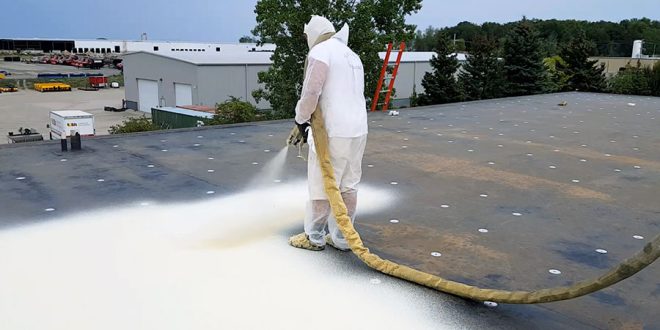Spray foam roofing, or Spray Polyurethane Foam (SPF), is a durable and highly effective roofing system commonly used in both residential and commercial properties. Its advantages include energy efficiency, excellent waterproofing, and seamless installation. However, like any roofing system, SPF roofing can experience issues over time.
The good news is that you can resolve these issues through repair, ensuring the roof continues to perform optimally. Below are some common issues in spray foam roofing that you can fix with the help of professionals.
Cracks and Gaps
Over time, spray foam roofing can develop cracks or gaps due to factors like physical impacts, expansion and contraction caused by temperature changes, or general wear and tear. These gaps can allow moisture to seep under the surface, leading to water damage and leaks.
Solution: Cracks and gaps can be easily repaired by applying additional foam to the affected areas. A professional roofing contractor can clean and prep the surface, then reapply the spray foam, restoring the roof’s watertight integrity. Once the foam is sprayed, it expands and hardens, sealing the cracks and gaps effectively. Make sure you hire only experienced professionals for spray foam roof repair.
Water Ponding
Ponding water occurs when water accumulates and remains stagnant on the roof for extended periods. This can happen due to poor drainage, flat roof design, or the roof settling unevenly. Over time, ponding water can cause foam degradation, leading to leaks and water infiltration.
Solution: To resolve ponding water, the roof may need to be re-sloped to allow proper drainage. This can be done by adding more foam to the low-lying areas or adjusting the slope to ensure water flows off the roof. The contractor may also inspect and clear any blockages in gutters or drains that may be contributing to the water buildup.
UV Degradation
While spray foam is known for its excellent protective properties, prolonged exposure to ultraviolet (UV) rays can cause the foam to degrade over time. This leads to brittleness, discoloration, and a reduction in performance, which can ultimately shorten the lifespan of the roof.
Solution: UV damage can be prevented by applying a reflective elastomeric coating over the foam. If the roof is already showing signs of UV degradation, the damaged sections can be cleaned and re-coated to protect the foam from further sun damage and extend the life of the roof.
Moisture Intrusion
Though spray foam is highly effective at preventing moisture infiltration, improper installation or damage over time can lead to moisture seeping beneath the foam. Trapped moisture can cause mold, mildew, and wood rot, weakening the roof structure.
Solution: If moisture intrusion is detected, the affected areas of foam will need to be removed, and the roof deck may need to be dried and inspected for damage. After drying, fresh foam can be sprayed over the area, restoring the roof’s ability to keep out water. Additionally, the roof’s drainage system should be checked and cleared to prevent future moisture buildup.
Physical Damage (Punctures or Dents)
Foam roofing can suffer from physical damage caused by falling debris, foot traffic, or even hailstorms. These damages can create punctures or dents in the foam, which, if left unchecked, could result in leaks or further degradation.
Solution: Physical damage like punctures and dents can be repaired by patching the affected areas with new foam. After the damaged section is cleaned and prepped, the contractor will spray fresh foam over it. Larger damage may require removing a section of foam and replacing it entirely. The surface is then coated to protect it from further damage.
Improper Adhesion to the Substrate
In some cases, the spray foam may fail to properly adhere to the roof deck or substrate. This could happen due to improper installation, moisture in the substrate, or extreme weather conditions. When foam does not adhere properly, it can lead to air pockets, gaps, and leaks.
Solution: If adhesion issues are found, the roofing professional may need to remove the poorly adhered foam and reapply it to ensure proper bonding. They may also check the surface for moisture or debris that could interfere with the adhesion and rectify any underlying issues before reapplying foam. You need to hire experienced professionals who offer the best services related to Phoenix roofing System.
Wear and Tear from Foot Traffic
Certain areas of the roof, such as near HVAC units, vents, or parapets, may experience more foot traffic during maintenance or inspections. This can lead to wear and tear, including thinning of the foam or surface cracking.
Solution: Regular foot traffic can be mitigated by installing walk pads in high-traffic areas. If damage has already occurred due to foot traffic, the affected areas can be patched or re-coated. In some cases, the foam may need to be resprayed to restore the roof’s structural integrity.
Temperature Fluctuations and Expansion
Temperature fluctuations can cause spray foam to expand and contract. Over time, this can cause the foam to crack, lift, or pull away from the substrate. Extreme temperature changes or sudden shifts in the weather can exacerbate these issues.
Solution: If foam has expanded or contracted due to temperature shifts, the roofing contractor will inspect the surface for cracks and gaps. It is possible by reapplying foam in the affected areas, ensuring a consistent and smooth surface.
Improper Installation
In some cases, issues with spray foam roofing may be due to improper installation. Failing to apply foam correctly may not provide adequate coverage, adhesion, or protection, which can lead to leaks and other problems.
Solution: If improper installation is identified, the solution may involve removing the old foam and reapplying it with proper techniques. Professionals can apply new foam evenly and thoroughly, eliminating any issues with coverage or performance.
Conclusion
Spray foam roofing is a durable and energy-efficient option, but it is not immune to problems. Fortunately, it is possible to resolve common issues with foam roofs, including cracks, gaps, water ponding, UV degradation, and physical damage by doing proper maintenance.
Regular inspections and timely repairs can extend the lifespan of the roof, ensuring that it continues to provide excellent performance and protection for the building. Working with a professional roofing contractor will help ensure to quickly resolve issues and keep the roof in optimal condition.
 Crypto trade Online Unlock the Future of Finance Today.
Crypto trade Online Unlock the Future of Finance Today.




